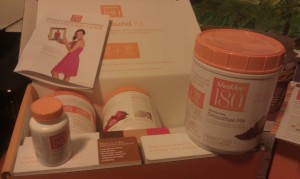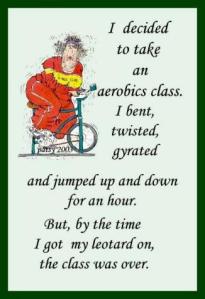Dear Reader, I have mentioned this energetic trainer, Lisa Stuebing in a former blog post. She and I walked the 3 miles around Greenlake at a quick pace. I was impressed with Lisa’s own story of sitting at a desk most of her professional life and slowed putting on weight and losing mobility. You should see her now. She’s slim and agile. I asked her to write a post to share with all my readers. Here it is:
The Second Most Popular New Year’s Resolution and the Positive Power of Excuses
Adapted from a speech given at the 12th Annual World Arthritis Day in Redmond, WA. October 2011.
Lisa Stuebing, Certified Personal Trainer and Senior Fitness Specialist, Owner, Mud Puddle Fitness, LLC
Did you know that the Second-Most-Popular -New-Year’s-Resolution-Of-All-Time is to become more fit? And yet, we often make the same resolution the following year. If you have arthritis, you have an extra challenge to keeping this resolution. Fortunately, you also have ready access to a powerful resource to ensure your success.
This essay is about the positive power of making excuses. Excuses are important. Now is the time to recognize that your excuses have strength and depth and validity.
Researchers find that three barriers to success recur over and over. 1.) Embarrassment, 2.) Procrastination, and 3.) Fear of injury. These well-funded longitudinal studies have included thousands of participants who in turn represent millions of excuse makers. They were conducted by reputable institutions like the Mayo Clinic, the American College of Sports Medicine, the National Institute of Health.
- EMBARASSMENT
Do you put off going to the pool until after you look good? Have you walked into a gym tried out some equipment and goose-stepped out of there because you didn’t want people you didn’t really know how to use it? Discouragement is a powerful inhibitor. Which leads us to the second big excuse honest people have for not getting regular exercise.
- PROCRASTINATION
“Procrastination is the art of keeping up with yesterday.”
– Don Marquis
What keeps you inside?
In a London study, 64% of the participants simply did not know what a good work out was supposed to feel like. So, they avoided it. Learning what is normal and what’s not normal takes time. It takes practice. When you are getting the right amount of exercise, during the best part of your day – you will build up your stamina. You will feel better and even energized at some level. And, yes, you will feel a little tired.
Finally, there is another big reason people tend to stay away from exercise.
- FEAR OF INJURY
People worry that because they are not athletes already that they will hurt themselves.
If you have arthritis, be a careful consumer of information. There is still a lot of bad information out there. You can still find literature that will tell you that exercise is not good for you. The old thinking is that physical activity will damage joints and make arthritis worse.
In reality, multiple studies have clearly shown that appropriate exercise for people with arthritis leads to better flexibility, strength and endurance. It also leads to less pain, fatigue and depression.
ACKNOWLEGE YOUR EXCUSES AND THEN TACKLE THEM ONE BY ONE
Find people who are doing fun stuff and do it with them. Laughing together is the best antidote for embarrassment.
Build up your knowledge and stamina one day at a time. The key is to start small and pace yourself — If you are going to take up cross country skiing – start with a small country.
Finally, if you have arthritis, know that hurt does not always equal harm. Take an Arthritis Foundation “Walk with Ease” class and learn to reduce your pain while getting fit.
Enroll in an Arthritis Foundation, “Walk with Ease” class
Take an Arthritis Foundation “Walk with Ease” class and you will learn how to set realistic goals. You will learn how to measure your progress. You will feel more energized because you will know the best time to exercise and how much exercise is right for you. You’ll meet new people and have tons of fun.
The Walk with Ease Course was developed by the Stanford University Patient Education Research Center.
The efficacy of the program was tested, studied and reviewed by the University of North Carolina in collaboration with the Thurston Arthritis Research Center and the University’s Institute on Aging.
The program’s published materials were made possible, in part, with funds from the Center for Disease Control.
In my professional opinion, the most important thing the Walk with Ease program teaches is an understanding of your pain. Hurt does not always equal harm. Sometimes, moving when you didn’t really want to, results in actually feeling better. This isn’t all hocus pocus – this is about focus. Focusing on you, testing yourself and then understanding the result. I think this takes the entire six weeks to learn and apply the program. And the bonus is, by the end of all 18 class sessions – you will have made a pleasant habit of joining friends for a little fun exercise. Some classmates get together long after the class had ended.
CONCLUSION
In conclusion, there are three steps to take. 1.) Work with yourself, understand your reluctance to plunge into a planned exercise routine and give yourself a break. Your concerns are real and based on a lifetime of personal observations. Be honest with yourself and then take the next step. 2.) Educate yourself; take the Arthritis Foundation’s “Walk with Ease”. Learn when exercise will reduce your pain and how to make that happen. Finally, 3.) Include yourself – join others for group activities. Invite friends out for a walk. Having fun with friends is your best chance of sticking with and enjoying a lifelong habit of exercise.
“Whatever you can do or dream you can, begin it. Boldness has genius, power and magic in it.” – Johann Wolfgang van Goethe
Let me know how you do! Please do not hesitate to contact me if you have any questions.
Coach Lisa
Lisa Stuebing
Owner, Mud Puddle Fitness, LLC
Nationally Certified Personal Trainer and Senior Fitness Specialist
www.MudPuddleFitness.com
CoachLisa@MudPuddleFitness.com
206-524-6788
 basket ball but is suffering from serious sciatica, shakes he head a
basket ball but is suffering from serious sciatica, shakes he head a  The product changed that. So my body gave me a testimony. Not content with physical data alone, I researched the company, ordered a couple of its peer-reviewed, published research articles and did a library search for back ground information. (This was back in the days before the internet.) All my due diligence confirmed my own experience. I developed brand loyalty over the next couple years, the way people line up for the next Apple product.
The product changed that. So my body gave me a testimony. Not content with physical data alone, I researched the company, ordered a couple of its peer-reviewed, published research articles and did a library search for back ground information. (This was back in the days before the internet.) All my due diligence confirmed my own experience. I developed brand loyalty over the next couple years, the way people line up for the next Apple product.


